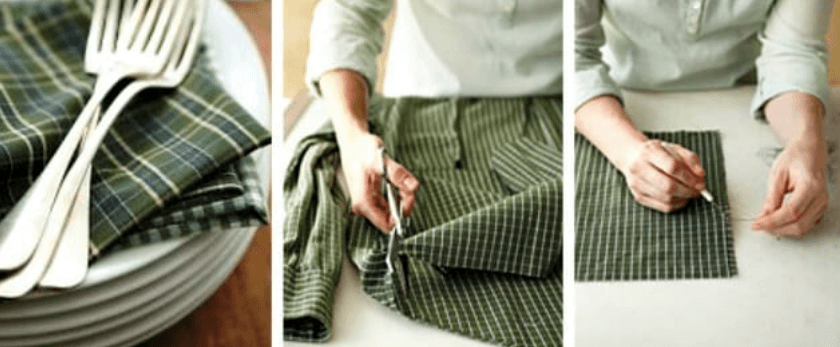In today's world, where environmental concerns are at the forefront of our minds, it's important to consider the impact of our daily choices on the planet. One simple way to reduce our carbon footprint is by making our own homemade napkins. Not only is this a more eco-friendly option, but it also allows us to save money and express our creativity. In this article, we'll explore why traditional napkins are harmful to the environment, the benefits of making your own, and how to make them at home.
The Environmental Impact of Traditional Napkins
It may seem harmless to use disposable napkins, but the truth is that they have a significant impact on the environment. Here are some reasons why:
- Deforestation: The production of paper napkins contributes to deforestation, as trees are cut down to make them. This not only destroys natural habitats but also reduces the amount of carbon dioxide that trees absorb, contributing to climate change.
- Water and Energy Consumption: The production of paper napkins requires a significant amount of water and energy. This not only depletes natural resources but also contributes to air and water pollution.
- Landfill Waste: Disposable napkins are often used for a short period and then thrown away, ending up in landfills. These landfills emit harmful greenhouse gases and take up valuable space.
- Chemical Pollution: The production of paper napkins involves the use of chemicals such as chlorine, which can pollute the air and water.
The Benefits of Making Your Own Napkins
Making your own napkins may seem like a small step, but it has a big impact on the environment. Here are some reasons why:
- Reduced Waste: By making your own napkins, you eliminate the need for disposable ones, reducing the amount of waste that ends up in landfills.
- Saves Money: Making your own napkins is a cost-effective option in the long run. You can use old fabric or repurpose old clothes, saving you money on buying disposable napkins.
- Customizable: Making your own napkins allows you to express your creativity and personalize them according to your style and preferences.
- Eco-Friendly Materials: You have control over the materials you use, ensuring that they are environmentally friendly and sustainable.
- Teaches Valuable Skills: Making your own napkins is a simple and fun DIY project that can teach you valuable skills and inspire you to make other eco-friendly changes in your life.

What You'll Need to Make Homemade Napkins
Making your own napkins is a simple and straightforward process. Here are the materials you'll need:
- Fabric: Choose a fabric that is durable, absorbent, and easy to clean. Cotton, linen, and hemp are all great options.
- Scissors: A good pair of fabric scissors will make cutting the fabric easier.
- Sewing Machine or Needle and Thread: You can use a sewing machine for faster and more precise stitching, or you can hand-sew the napkins if you prefer.
- Ruler or Measuring Tape: This will help you measure and cut the fabric to the desired size.
- Iron: An iron will help you create crisp edges and folds in the fabric.
- Optional: You can also use fabric paint, stamps, or embroidery thread to add a personal touch to your napkins.
How to Make Homemade Napkins
Now that you have all the necessary materials, here are the steps to make your own napkins:
- Measure and Cut the Fabric: Use a ruler or measuring tape to measure and cut the fabric into squares of your desired size. A standard napkin size is 18x18 inches, but you can make them larger or smaller according to your preference.
- Fold and Iron: Fold the edges of the fabric twice, about ¼ inch each time, and iron them to create a clean and crisp edge.
- Sew the Edges: Using a sewing machine or needle and thread, sew along the folded edges to secure them in place. You can use a straight stitch or a decorative one for added flair.
- Optional: If you want to add a personal touch to your napkins, you can use fabric paint, stamps, or embroidery thread to create designs or monograms.
- Wash and Reuse: Once your napkins are complete, wash them before use to remove any excess fabric or chemicals. You can then use them as you would use disposable napkins, and when they get dirty, simply wash and reuse them.
Responsible Disposal of Homemade Napkins
While homemade napkins are a more sustainable option, it's essential to dispose of them responsibly to ensure they don't end up in landfills. Here are some tips for responsible disposal:
- Compost: If you use natural and biodegradable fabrics, such as cotton or linen, you can compost your napkins once they are worn out. This will return the nutrients to the soil and reduce waste.
- Donate or Repurpose: If your napkins are still in good condition, you can donate them to a thrift store or repurpose them into cleaning rags or other household items.
- Recycle: If your napkins are made of synthetic materials, such as polyester, you can recycle them at a textile recycling facility. Check with your local recycling center for more information.
Conclusion
Making your own napkins is a simple and effective way to reduce your environmental impact and live a more sustainable lifestyle. By using eco-friendly materials and responsible disposal methods, you can make a positive impact on the planet. So why not give it a try and make your own homemade napkins today? Your wallet and the environment will thank you.










